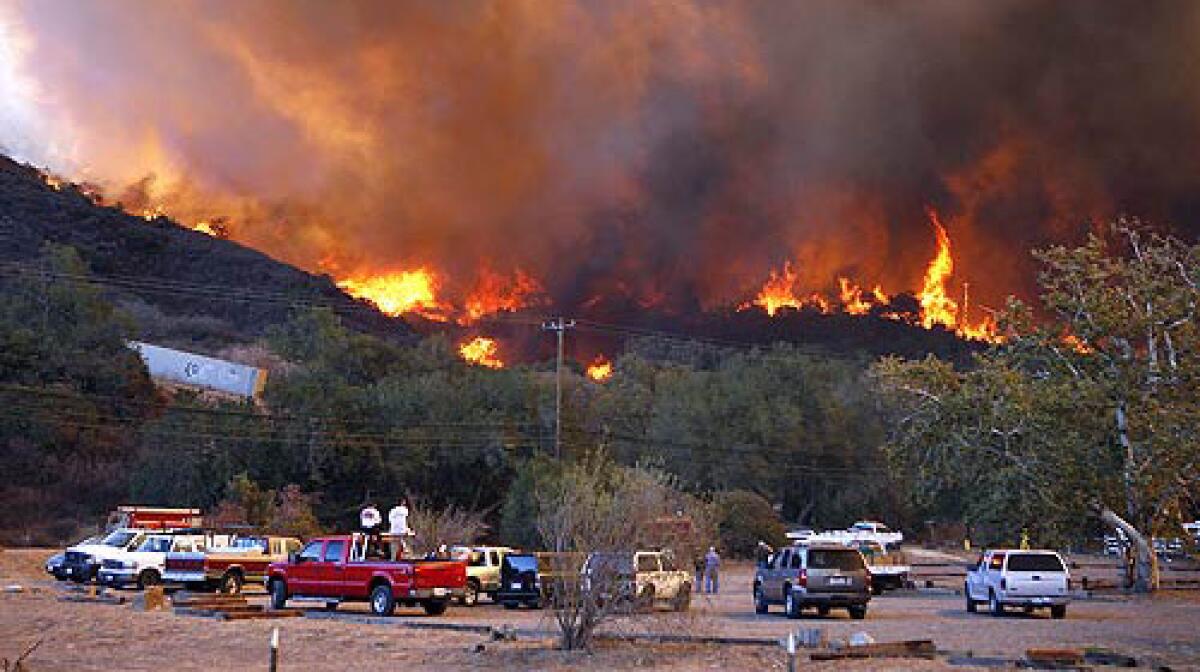O.C. Fire Chief: ‘Had we had more air resources, we would have been able to control this fire’

- Share via
At least a dozen Orange County homes had burned by this morning and thousands more were in danger as flames as high as 75 feet devastated rural canyon communities, fire officials said.
The Santiago fire continued to push east today, fueled by brittle canyon brush as it threatened communities around Modjeska Canyon. On Tuesday, panicked residents begged firefighters for help.
“I lived through eight fires out here, and I’ve never seen anything like this,” Mark Jackson said before his century-old wooden home burned to the ground in Modjeska Canyon. “Why can’t you do anything?”
Local fire officials were similarly frustrated, arguing that if the state had provided adequate aircraft and personnel Sunday, the devastation could have been prevented.
The fire was set near Santiago and Silverado canyons in a way to maximize its spread, authorities said, and will probably take at least two weeks to contain.
“It is an absolute truth -- had we had more air resources we would have been able to control this fire,” Orange County Fire Authority Chief Chip Prather said.
Erratic winds gusting up to 60 mph continued to fuel the arsonist’s blaze, which expanded to more than 19,200 acres this morning and prompted the evacuation of about 3,000 people.
Heat and flames in the Santa Ana Mountains were so intense that firefighters at times couldn’t safely enter Modjeska Canyon, where at least 11 homes were destroyed, officials said.
“It’s chaos right now, it’s total chaos,” said Assemblyman Todd Spitzer (R-Orange).
About 600 firefighters battled the blaze, which had a 38-mile perimeter and caused more than $10 million in damage. Late Tuesday afternoon, firefighters set backfires to stop flames from racing through O’Neill Regional Park and into Rancho Santa Margarita, and air-dropped fire retardant to halt the fire’s push into the Santiago Canyon Estates neighborhood.
Firefighters’ efforts were hampered by wind conditions, which at times grounded air tankers and helicopters.
A new challenge emerged as offshore Santa Ana winds collided with onshore coastal winds and air currents from the fire, creating a swirling micro-climate that made fighting the fire in tight canyons more dangerous and unpredictable.
The fire’s containment remained at 30%, unchanged since Monday.
Sue Geraci sobbed and nearly collapsed when she saw the burned remains of her multimillion-dollar Modjeska home.
“We have a pump house and water tank,” said Geraci, who had lived there five years.
“Our house was supposed to be fireproof. We watered and we watered and we watered.”
Mandatory evacuations began early Tuesday in Modjeska Canyon and spread to other canyon communities, including Silverado and Trabuco. Hundreds of animals, including horses and llamas, were evacuated to stables elsewhere in Southern California.
Shelters were set up at El Modena High School in Orange and El Toro High School in Lake Forest. About 270 evacuees from Orange and San Diego counties spent Monday night sleeping on cots in El Toro High’s gym. During the day, some took naps or crowded around a TV, eyes glued to the flashes of flame on the screen.
“I called home and heard my answering machine, so that’s good news,” said Kenneth Samuels, 67, of Fallbrook.
Sixty-one teenage boys living at a Trabuco Canyon juvenile detention center were evacuated about 6 a.m. to Santa Ana.
In addition to the 11 burned Modjeska Canyon homes, the fire gutted a double-wide mobile home and an outbuilding and damaged three other buildings in the vicinity, fire officials reported.
“There’s a lot of hard work ahead of us,” said Rich Witesman of the county fire authority.
Local firefighters -- who saw support from the state and other outside agencies Tuesday for the first time, including four air tankers, two helicopters and more than 100 firefighters -- were told not to expect many more resources in the near future.
“We put in a request for a lot of outside resources that just plain are not available,” Capt. Stephen Miller said. “As you’re seeing what’s going on in Southern California, everybody’s stretched pretty thin.”
Even firefighters on the scene were occasionally pulled back because of the blaze’s unpredictable behavior.
Early Tuesday, firefighters from Station 16, a tight-knit volunteer station in Modjeska, stopped at the mouth of the canyon with tears in their eyes, helpless as their and their neighbors’ homes were threatened by flames.
Many have served in the department for decades.
Residents of Lake Forest were guardedly relieved early Tuesday, as the flames appeared to have turned away from their communities.
On Monday, the fire came within 50 yards’ of Jill Shefsky’s house, and burning embers the size of her palm rained down around her.
“I wasn’t sure if we’d be those people who were picking through the remains of our house today,” the 43-year-old homemaker said as she swept soot out of her garage. “I’m just glad my home is here.”
But in the canyons, residents braced for the worst.
As planes dropped fire retardant on the hillsides near Santiago Canyon Estates, 16-year-old Fady Najjar watered down the palm trees in front of his family’s home.
“This morning they said the fires were all over, and 20 minutes later the hill was on fire,” he said. His cousin Rob Zahr, 36, interrupted: “Get ready, it’s getting time to go. . . . Get a towel for your face.”
Contributing to this report were Times staff writers Tony Barboza, David Reyes, Janet Wilson, Karen Tapia and My-Thuan Tran and news assistant Nardine Saad.
More to Read
Sign up for Essential California
The most important California stories and recommendations in your inbox every morning.
You may occasionally receive promotional content from the Los Angeles Times.











